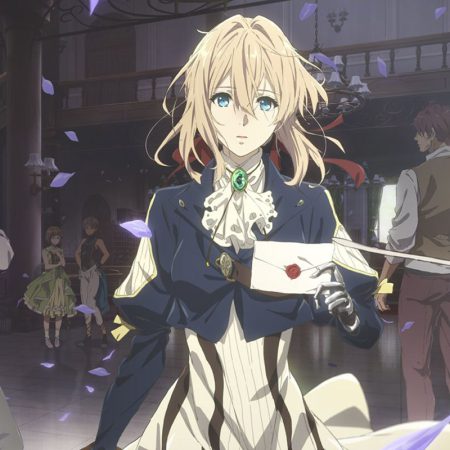Perfect Blue is a groundbreaking anime film that has captivated audiences for over two decades. Directed by Satoshi Kon and released in 1997, this psychological thriller continues to be influential in modern cinema. One of the most striking visual elements of the film is the masterful use of the color red. In this article, we will explore the significance and symbolism behind the use of red in Perfect Blue, examining how it enhances the narrative and adds depth to the story.
Red as a Symbol of Transformation and Identity
In Perfect Blue, the color red is often associated with themes of transformation and identity. The protagonist, Mima Kirigoe, is a former pop star who decides to pursue a career in acting. As she navigates this new path, her world becomes increasingly blurred and her sense of self begins to unravel. The color red serves as a constant reminder of her previous life as a pop star and the internal conflict she experiences.
The use of red is particularly prominent in scenes where Mima is faced with moral dilemmas or moments of self-reflection. It symbolizes the tension between her past and present selves, as well as the doubts and expectations others have for her. The color acts as a visual cue, highlighting the struggles Mima faces as she tries to reconcile her new identity with the expectations placed upon her.
Red as a Representation of Psychological Distress
Another significant aspect of the use of red in Perfect Blue is its association with psychological distress. As the film progresses, Mima’s mental state deteriorates, and the color red becomes more prevalent. It is often used to depict moments of intense emotional turmoil and psychological instability.
The color red is used in scenes that explore the darker aspects of Mima’s journey. It is present during instances of violence, both physical and psychological, and serves to intensify the impact of these moments on the audience. The use of red in these scenes creates a sense of unease and discomfort, effectively conveying the psychological distress experienced by Mima.
Red as a Symbol of Voyeurism and Exploitation
Perfect Blue delves into themes of voyeurism and exploitation within the entertainment industry. The color red is utilized to highlight these themes and emphasize the objectification of Mima as a celebrity. In several scenes, red is used in conjunction with images of Mima being watched or observed, creating an eerie and unsettling atmosphere.
The color red also appears in scenes that depict the exploitative nature of the entertainment industry. It serves as a visual cue, reminding the audience of the dangers and pitfalls that come with fame and success. By using red in these contexts, the film exposes the dark underbelly of celebrity culture and raises questions about the price of fame.
Red as a Marker of Reality and Fantasy
Perfect Blue blurs the lines between reality and fantasy, and the color red plays a significant role in distinguishing between these two realms. In the film, the sky is often depicted as a clear blue, representing Mima’s state of mind and her connection to reality. However, as the story progresses and Mima’s grip on reality slips, the sky becomes more clouded and precipitated, symbolizing her descent into confusion and uncertainty.
Conversely, scenes that depict moments of unreality or delusion are often accompanied by red elements. For example, Mima’s stalker’s room is filled with images of her in poses reminiscent of her pop star days, which come to life and speak to her. The use of red in these scenes serves as a visual indicator that what is unfolding is not grounded in reality, but rather a product of Mima’s troubled mind.
Red as a Signifier of Violence and Bloodshed
Perfect Blue is not for the faint of heart, as it contains graphic depictions of violence and bloodshed. The color red is used extensively in these scenes to emphasize the brutality and visceral nature of the violence portrayed. It serves as a stark contrast against the predominantly muted color palette of the film, drawing attention to the gruesome acts unfolding on screen.
The use of red in these violent scenes heightens the impact on the audience, evoking feelings of shock and discomfort. It adds a layer of intensity and realism to the film, further immersing viewers in the harrowing experiences of the characters.
Red as a Design Element
Beyond its symbolic and thematic significance, the color red is also utilized as a design element in Perfect Blue. The character designs in the film are realistic, with anime features such as large eyes and small noses. The use of red in the characters’ wardrobes and the color schemes of certain scenes adds visual interest and variety.
Additionally, the animation itself incorporates red in the backgrounds and settings. The streets of 1990s Tokyo are depicted with meticulous detail, featuring red accents that add vibrancy to the cityscape. The use of red in these design elements enhances the overall visual appeal of the film, creating a visually captivating experience for the audience.
Verdict
The use of red in Perfect Blue is a testament to the film’s meticulous attention to detail and its ability to convey complex emotions and themes. From symbolizing transformation and identity to representing psychological distress and violence, the color red serves as a powerful visual tool throughout the narrative. Its presence adds depth and intensity to the story, immersing viewers in the psychological thriller that unfolds on screen.
Perfect Blue continues to be an influential and highly regarded film in the world of anime and cinema. Its masterful use of color, particularly red, contributes to its lasting impact and leaves a lasting impression on audiences. Whether it is used to signify transformation, evoke psychological distress, or enhance the visual design, the use of red in Perfect Blue is a testament to the film’s artistry and storytelling prowess.








